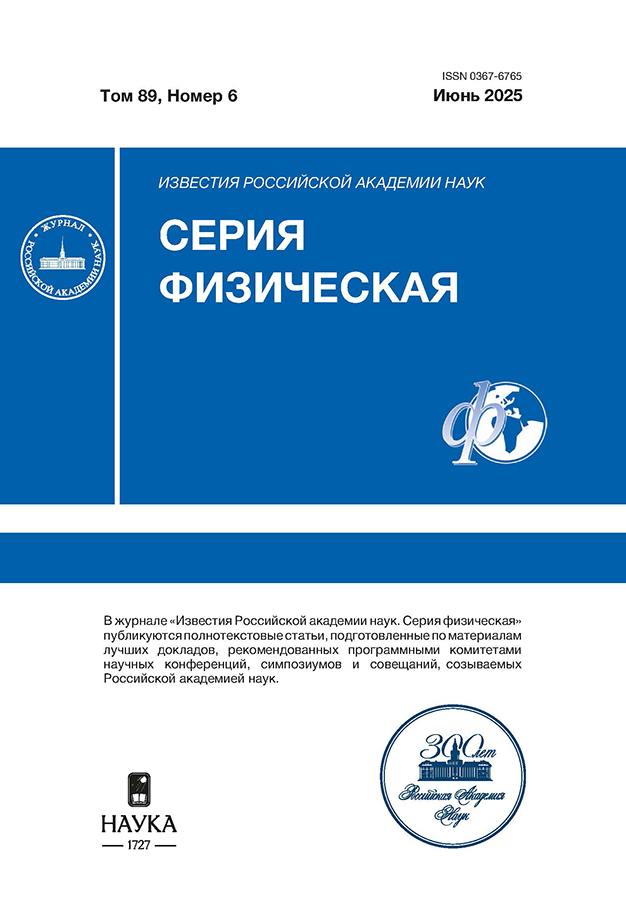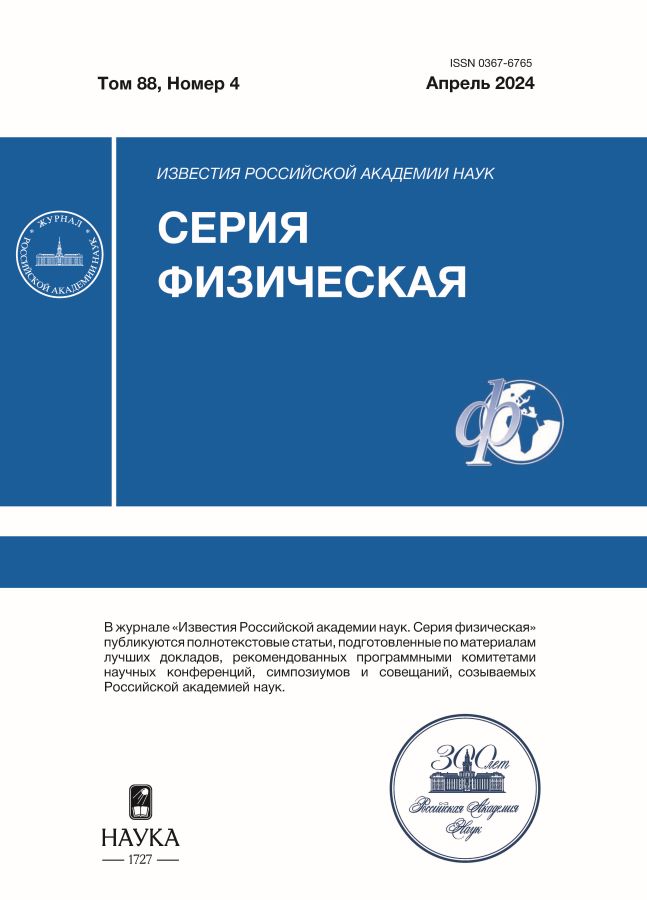Ферромагнитный резонанс и магнитная анизотропия композиционно модулированных нитей на основе 3-d металлов
- Авторы: Денисова Е.А.1,2, Чеканова Л.А.1, Комогорцев C.В.1,3, Исхаков Р.С.1, Важенина И.Г.1,2, Немцев И.В.1,2,4, Ли О.А.2,4
-
Учреждения:
- Институт физики имени Л. В. Киренского Сибирского отделения Российской академии наук – обособленное подразделение Федерального государственного бюджетного научного учреждения “Федеральный исследовательский центр Красноярский научный центр Сибирского отделения Российской академии наук”
- Федеральное государственное автономное образовательное учреждение высшего образования “Сибирский федеральный университет”
- Федеральное государственное бюджетное образовательное учреждение высшего образования “Сибирский государственный университет науки и технологий имени академика М. Ф. Решетнева”
- Федеральное государственное бюджетное научное учреждение “Федеральный исследовательский центр “Красноярский научный центр Сибирского отделения Российской академии наук”
- Выпуск: Том 88, № 4 (2024)
- Страницы: 618-622
- Раздел: Магнитные явления и умные композитные материалы
- URL: https://cijournal.ru/0367-6765/article/view/654708
- DOI: https://doi.org/10.31857/S0367676524040131
- EDN: https://elibrary.ru/QHMYLL
- ID: 654708
Цитировать
Полный текст
Аннотация
Обсуждаются результаты исследования характеристик спектров ферромагнитного резонанса массивов нитей Co-Ni, Co-Fe-Ni с различным композиционным профилем, осажденных в поликарбонатные трековые мембраны. Исследовано влияние межфазных границ и градиентов концентрации на эффективное поле исследуемых нитей. Наблюдается аномальная угловая зависимость резонансных полей ФМР для ансамблей таких нитей при плотности пор в мембране ~18%.
Полный текст
Об авторах
Е. А. Денисова
Институт физики имени Л. В. Киренского Сибирского отделения Российской академии наук – обособленное подразделение Федерального государственного бюджетного научного учреждения “Федеральный исследовательский центр Красноярский научный центр Сибирского отделения Российской академии наук”; Федеральное государственное автономное образовательное учреждение высшего образования “Сибирский федеральный университет”
Автор, ответственный за переписку.
Email: len-den@iph.krasn.ru
Россия, Красноярск; Красноярск
Л. А. Чеканова
Институт физики имени Л. В. Киренского Сибирского отделения Российской академии наук – обособленное подразделение Федерального государственного бюджетного научного учреждения “Федеральный исследовательский центр Красноярский научный центр Сибирского отделения Российской академии наук”
Email: len-den@iph.krasn.ru
Россия, Красноярск
C. В. Комогорцев
Институт физики имени Л. В. Киренского Сибирского отделения Российской академии наук – обособленное подразделение Федерального государственного бюджетного научного учреждения “Федеральный исследовательский центр Красноярский научный центр Сибирского отделения Российской академии наук”; Федеральное государственное бюджетное образовательное учреждение высшего образования “Сибирский государственный университет науки и технологий имени академика М. Ф. Решетнева”
Email: len-den@iph.krasn.ru
Россия, Красноярск; Красноярск
Р. С. Исхаков
Институт физики имени Л. В. Киренского Сибирского отделения Российской академии наук – обособленное подразделение Федерального государственного бюджетного научного учреждения “Федеральный исследовательский центр Красноярский научный центр Сибирского отделения Российской академии наук”
Email: len-den@iph.krasn.ru
Россия, Красноярск
И. Г. Важенина
Институт физики имени Л. В. Киренского Сибирского отделения Российской академии наук – обособленное подразделение Федерального государственного бюджетного научного учреждения “Федеральный исследовательский центр Красноярский научный центр Сибирского отделения Российской академии наук”; Федеральное государственное автономное образовательное учреждение высшего образования “Сибирский федеральный университет”
Email: len-den@iph.krasn.ru
Россия, Красноярск; Красноярск
И. В. Немцев
Институт физики имени Л. В. Киренского Сибирского отделения Российской академии наук – обособленное подразделение Федерального государственного бюджетного научного учреждения “Федеральный исследовательский центр Красноярский научный центр Сибирского отделения Российской академии наук”; Федеральное государственное автономное образовательное учреждение высшего образования “Сибирский федеральный университет”; Федеральное государственное бюджетное научное учреждение “Федеральный исследовательский центр “Красноярский научный центр Сибирского отделения Российской академии наук”
Email: len-den@iph.krasn.ru
Россия, Красноярск; Красноярск; Красноярск
О. А. Ли
Федеральное государственное автономное образовательное учреждение высшего образования “Сибирский федеральный университет”; Федеральное государственное бюджетное научное учреждение “Федеральный исследовательский центр “Красноярский научный центр Сибирского отделения Российской академии наук”
Email: len-den@iph.krasn.ru
Россия, Красноярск; Красноярск
Список литературы
- Pereira A., Palma J.L., Vázquez M. et al. // Phys. Chem. Chem. Phys. 2015. V. 17. P. 5033.
- Rial J., Proenca M.P. // Nanomaterials. 2020. V. 10. P. 2403.
- Darques M., Spiegel J., De la Torre Medina J. et al. // J. Magn. Magn. Mater. 2009. V. 321. P. 2055.
- Parkin S.S., Hayashi M., Thomasй L. et al. // Science. 2008. V. 320. No. 11. P. 190
- Wang D.-S., Mukhtar A., Wu K.-M., Gu L., Cao X. // Materials. 2019. V. 12. P. 3908.
- Zeng M., Yang H., Liu J., Yu R. // J. Appl. Phys. 2014. V. 115. Art. No. 17B514.
- Загорский Д.Л., Долуденко И.М., Каневский В.М. и др. // Изв. РАН. Сер. физ. 2021. Т. 85. № 8. С. 1090; Zagorskiy D.L., Doludenko I.M., Kanevsky V.M. et al. // Bull. Russ. Acad. Sci. Phys. 2021. V. 85. No. 8. Р. 848.
- Yang H., Li Y., Zeng M. et al. // Sci. Reports. 2016. V. 6. Art. No. 20427.
- Méndez M., Gonzalez S., Vega V. et al. // Crystals. 2017. V. 7. No. 3. P. 66.
- Bran C., Ivanov Y.P., Kosel J. et al. // Nanotechnology. 2017. V. 28. No. 9. Art. No. 095709.
- Denisova E.A., Chekanova L.A., Komogortsev S.V. et al. // IEEE Trans. Magn. 2022. V. 58. No. 2. Art. No. 2300805.
- Iskhakov R.S., Chekanova L.A., Denisova E.A. // IEEE Trans. Magn. 1997. v. 33. No. 5. P. 3730.
- Kittel C. // Phys. Rev. 1948. V. 73. No. 2. Р. 155.
Дополнительные файлы














